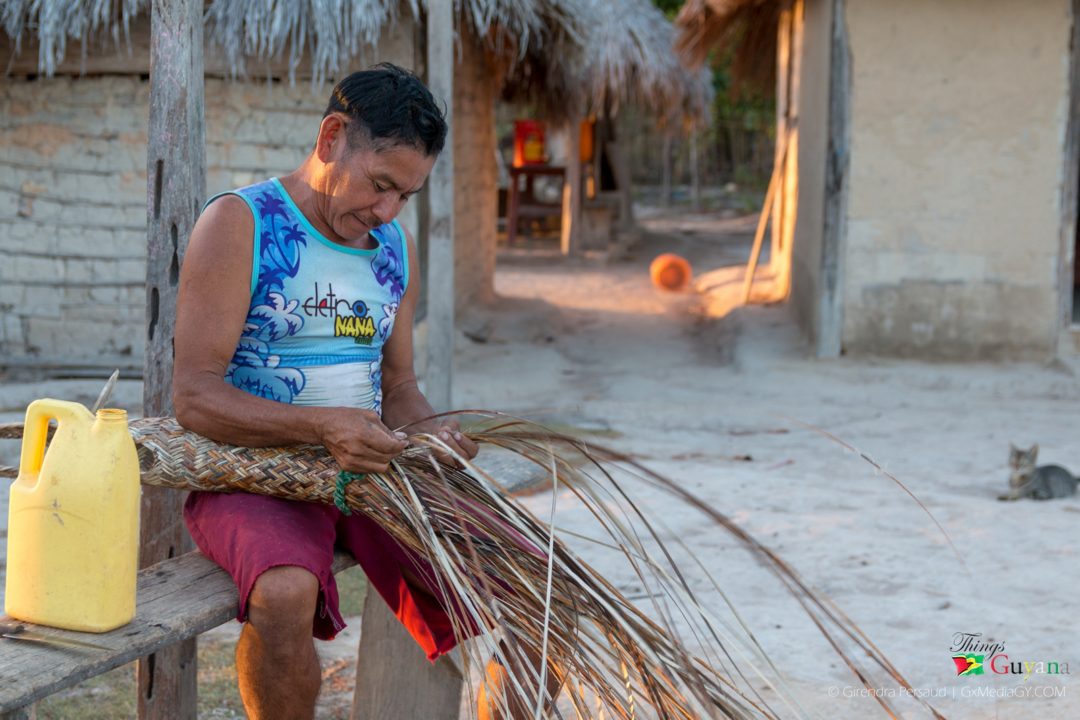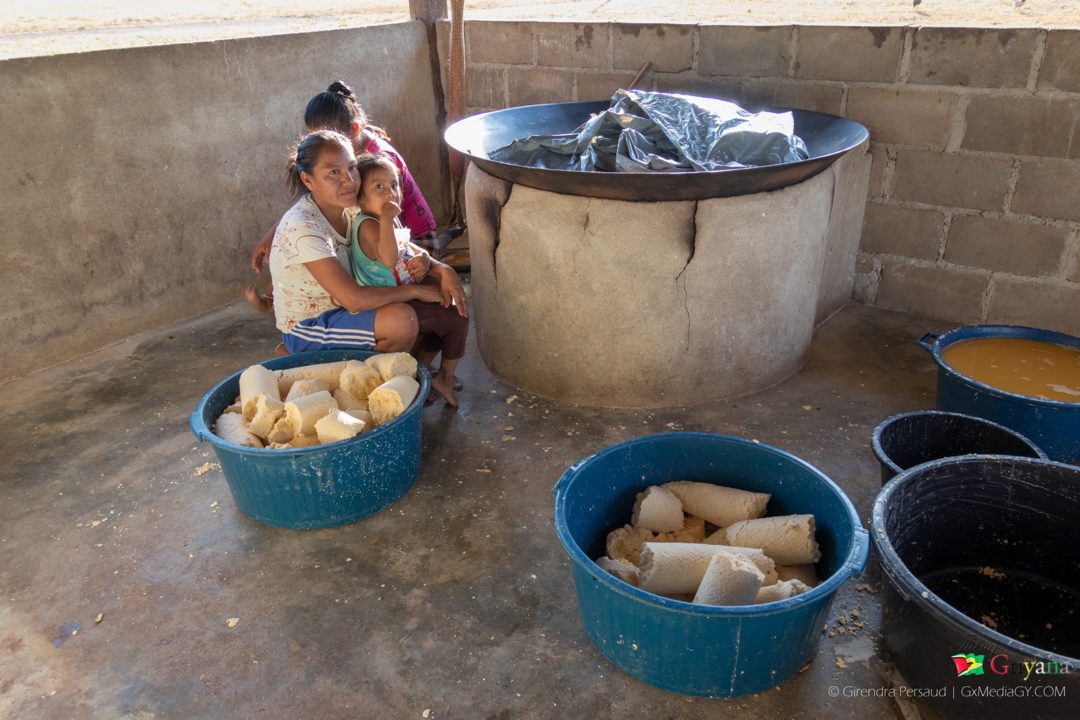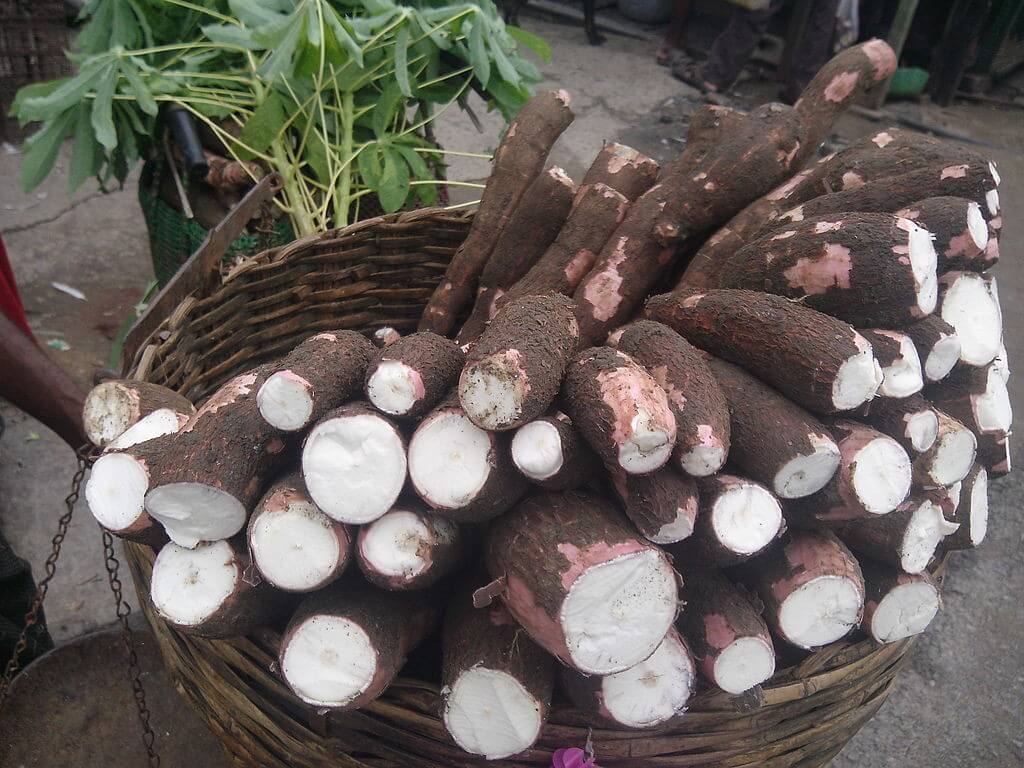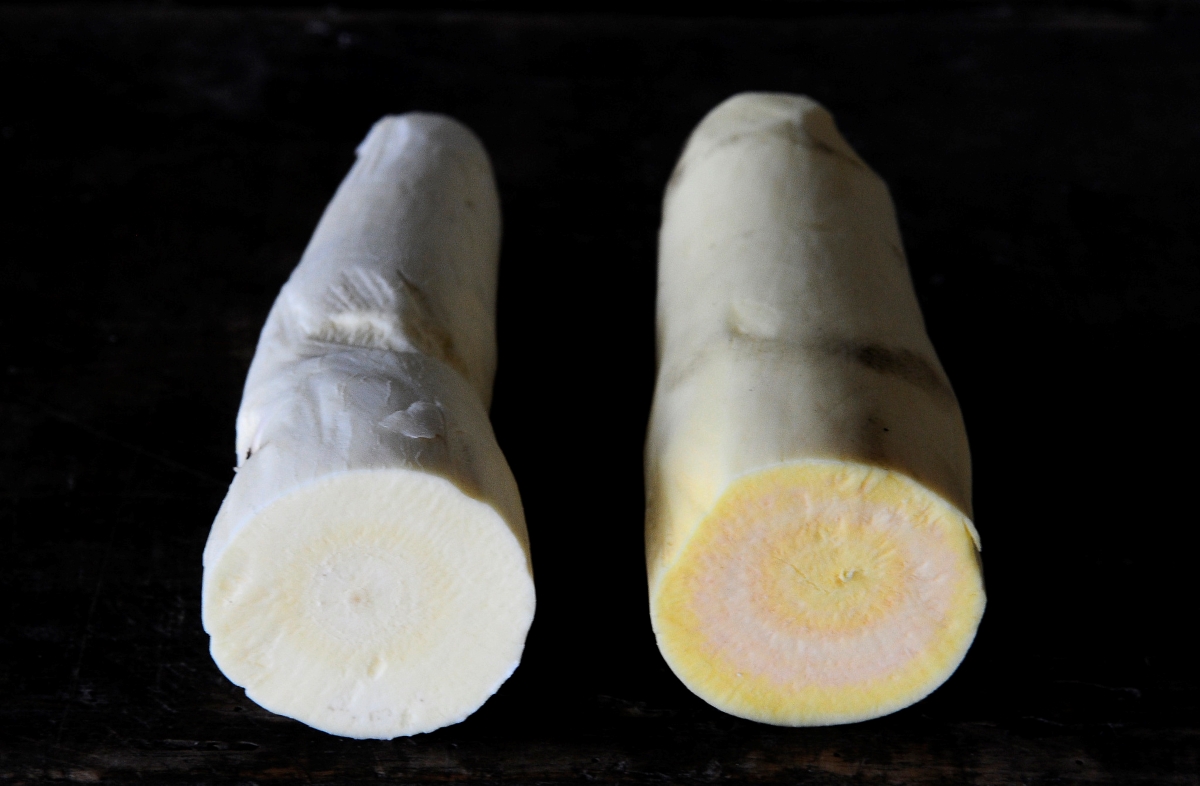What is it?
Cassava is a tropical, flavorful, starchy root vegetable that is a staple food of the indigenous people of Guyana. Cassava, also known as yucca, manioc or mandioca is a tuber crop, similar to potatoes and yam and an important source of nutrients and energy. Each tuber weighs one to several pounds depending upon the cultivar type. The texture of its skin is gray-brown, rough and woody. The interior flesh features white, starch-rich sweet-flavoured meat.
Cassava is a perennial plant with perceptible, fan-shaped leaves resembling those of the related castor-oil plant but there are more lobes that are deeply parted. Cassava varies from low herbs to branching shrubs and slender unbranched trees. Some are adapted to dry areas of alkaline soil and others to acid mud banks along rivers.
Did you know Cassava is actually poisonous?

Amerindian Man Making Matapee For Processing Cassava
Cassava can be either sweet or bitter. However, eating raw cassava is not recommended since the plant contains cyanogenic glucosides that your body can convert into potentially toxic cyanide, according to Purdue University, so it must be cooked before it is consumed.
Cassava is placed in a squeezer called matapi which allows the poisonous substance to be removed and dried. The extracted juice is then boiled and that’s how we get cassareep which is a popular by-product of cassava used especially for the dish pepperpot. When dried, thin cakes known as cassava bread is made by pounding up the residuum which then passes through a sifter and placed on a circular clay grid to give its shape. It is a famous folk dish in the Guyanese society, especially when toasted and buttered with cooking butter or margarine.
Origin of Cassava
Cassava is native to Brazil, South America and has been part of the Caribbean diet way before the Christopher Columbus discovery. History has it that the cassava originated in Nigeria, on the continent of Africa, and until today Nigeria continues to be one of the largest producers of cassava while Thailand is the largest exporter of dried cassava.
It was also said that the Europeans brought the plant all the way from Africa to cultivate in the Caribbean. Cassava still plays a vital role in Guyana cuisine today.
Scientific Classification of Cassava
Cassava, a nutty flavoured, starch-tuber is in the spurge family (Euphorbiaceae) of plants. Its scientific name is Manihot esculenta (Crantz).
Kingdom: Plantae
Clade: Tracheophytes
Clade: Angiosperms
Clade: Eudicots
Clade: Rosids
Order: Malpighiales
Family: Euphorbiaceae
Genus: Manihot
Species: M. esculenta
Health Benefits of Cassava

Cassava Processing Yupukari Village, North Rupununi, Guyana
- The root of the plant is used to make tapioca, a starch found in puddings and other foods. Taking cassava in dietary supplement form is said to be very beneficial to one’s health including enhanced fertility.
- Cassava also is purported to reduce inflammation and increase stamina.
- In folk medicine, the roots of the cassava are applied directly to the skin (often in the form of a poultice) to promote the healing of wounds and sores.
- The peel of cassava plants can be used as a skin exfoliator to smoothen and brightenskin complexion.
- Its roots and leaves can be used to make a fresh paste that can be applied on oiled hair an hour before you rinse it.
- Cassava leaves are full of lysine protein. This makes the leaves perfect for fighting against protein deficiency conditions like Kwashiorkor.
Nutritional Facts
The root of the cassava plant contains significant amounts of several nutrients, including calcium and vitamin C. The plant’s leaves, meanwhile, have been found to contain protein, carotene, and lysine. Cassava is the third-largest source of food carbohydrates in the tropics, after rice and maize. It is one of the most drought-tolerant crops, capable of growing on marginal soils.
A 3.5-ounce (100-gram) serving of boiled cassava root contains 112 calories. 98% of these are from carbs and the rest are from a small amount of protein and fat. This serving also provides fiber, as well as a few vitamins and minerals.
The following nutrients are found in 3.5 ounces (100 grams) of boiled cassava :
- Calories:112
- Carbs:27 grams
- Fiber:1 gram
- Thiamine:20% of the RDI
- Phosphorus:5% of the RDI
- Calcium:2% of the RDI
- Riboflavin:2% of the RDI
- Zinc: 0.34mg, 3% of the RDI
- Manganese: 0.383mg, 1.5% of the RDI
- Magnesium: 21 mg, 5% of the RDI
- Potassium: 271mg, 6% of the RDI
- Sodium: 14mg, 1% of the RDI
Boiled cassava root also contains small amounts of iron, protein, vitamin A, C, E, K , riboflavin, pyridoxine and niacin.
How Cassava is Grown & Harvested

Cassava – Photo By Thamizhpparithi Maari – Own work, CC BY-SA 3.0, https://commons.wikimedia.org/w/index.php?curid=28533437
Cassava grows best under tropical, moist, fertile, and well-drained soils. The completely grown plant reaches about 2-4 m in height. In the fields, its cut-stem sections planted into the ground to propagate similarly to that of sugarcanes. After about 8-10 months of the plantation; long, globular roots or tubers grow downwards in a radial pattern, deep into the soil from the bottom end of the stem up to the depth of 2-4 feet.
Cassava is harvested by hand by raising the lower part of the stem and pulling the roots out of the ground, after which it is removed from the base of the plant. The upper parts of the stems with the leaves are plucked off before harvest.
How To Eat/Use Cassava

Cassava -Photo by Neil Palmer (CIAT)
- Select the root that is firm and free from blemishes.
- Peel the root using a sharp knife.
- Slice the root in half.
- Remove the woody core.
- Besides famous snacks and dishes, cassava can be enjoyed in the form of tapioca. This is a starch extracted from the cassava root through a process of washing and pulping. Tapioca is commonly used as a thickener for puddings, pies and soups.
How Cassareep Is Made
Cassava In Guyana
Cassava can be used to make cassava flours, snack such as cassava ball, egg ball, cassava pone, fry cassava, cassava chips. These delicious snacks can be found in school canteens, road vendors and local restaurants. In addition, many homes in Guyana add cassava to meals such as metemgee and soup whereby it serves as one of the ground provisions used in the dishes. Cassava is also used to produce strong drinks such as piwari and cassava wine. The Amerindians of Guyana enjoy this drink especially at occasions of festivity and celebration. Cassava production in Guyana as at 2017 is worth a value of 5,374. This vegetable of the root of all Guyanese is appreciated by all and especially an attraction and must try for visitors.
References
- https://www.verywellfit.com/cassava-nutrition-facts-calories-carbs-and-health-benefits-4177847
- https://healthyeating.sfgate.com/nutrients-cassava-1342.html
- https://www.ncbi.nlm.nih.gov/pmc/articles/PMC21904
- http://www.fao.org/ag/agp/agpc/gcds/
- https://www.stylecraze.com/articles/benefits-of-cassava-on-your-skin-hair-and-health/#gref
- https://www.nutrition-and-you.com/cassava.html
- https://www.thespruceeats.com/how-to-peel-cut-and-prepare-yuca-2138100
- https://www.thespruceeats.com/cassava-yuca-recipes-2137742
- http://www.factfish.com/statistic-country/guyana/cassava,+production+quantity
- https://www.thespruceeats.com/what-is-farine-2137937
- https://www.britannica.com/plant/cassava
- https://www.healthline.com/nutrition/cassava
- https://www.thekitchn.com/a-staple-starch-cassava-manioc-yuca-ingredient-spotlight-176111
- http://exploreguyana.org/cassava-the-root-that-binds-all-guyanese/
- http://guyanachronicle.com/2014/09/29/the-wonder-that-is-cassava
- https://www.medicalnewstoday.com/articles/323756.php
- https://guyanatimesgy.com/efforts-on-stream-to-increase-cassava-yield/
- https://guide.michelin.com/sg/features/5-things-to-know-about-the-humble-cassava/news
- https://www.bbc.com/food/cassava
Last Updated: 2020-07-20







1 Comment